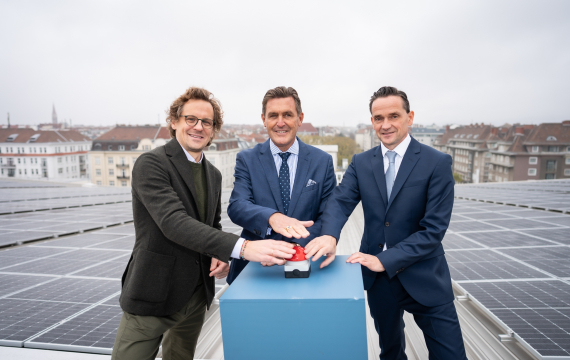HUGE PHOTOVOLTAIC SYSTEM COMPLETED

Vienna's largest roof for culture and entertainment will supply solar power starting in December
(Press release from 10.11.2022)
VIENNA. At the end of October, the last of the approximately 3,000 photovoltaic panels was installed on the roof of Hall D of the Wiener Stadthalle, a Wien Holding company. This meant that work on one of the largest inner-city photovoltaic systems on Austria's most important event location was completed on schedule and trial operation could begin after less than four months of construction. After a short test phase in November, the PV system will go into full operation in December. Wiener Stadthalle has thus taken a significant step towards greater sustainability and use of resources.
City Economic Councillor Peter Hanke, Wien Holding Managing Director Kurt Gollowitzer and Wiener Stadthalle Managing Director Matthäus Zelenka were now able to see for themselves the impressive dimensions of the completed plant.
"After the starting signal for the Vienna Solar Power Offensive, we can already present the first completed projects. With the scheduled completion of the new photovoltaic plant on the roof of the Vienna Stadthalle, we are once again a big step closer to our goal of making the city of Vienna climate-neutral by 2040. The plant has a total output of 1,123 kWp. Around 1.1 million kilowatt hours of electricity can thus be generated per year - which is roughly equivalent to the annual consumption of 580 one-person households in Vienna," says City Councillor for Economic Affairs Peter Hanke.
"As Wien Holding, we support the City of Vienna in achieving its climate targets. I am particularly pleased that one of the largest inner-city photovoltaic systems has now been realized on one of our companies. With the new PV system, which will go into full operation at the beginning of December, Wiener Stadthalle is making an important contribution to reducing greenhouse gases. With projects like this, we are contributing to the sustainable development of Vienna as an economic and living space," says Kurt Gollowitzer, Managing Director of Wien Holding.
This project is a milestone for the most important event location in the country and an essential step for the sustainability strategy of Wiener Stadthalle. In these challenging times, the Wiener Stadthalle team has succeeded in completing this important project within the planned time frame. Our goal is to generate 100 percent of the electricity consumed at the site green on site in the next five years through the interaction of energy-saving measures as well as the expansion of additional roof surfaces," explains Matthäus Zelenka.
2,956 PHOTOVOLTAIC MODULES INSTALLED ON THE ROOF OF HALL D
With almost five and a half thousand square meters, the area on the roof of Hall D covered by the photovoltaic system is as large as 21 tennis courts and is located at a height of 25 meters. A total of 2,956 photovoltaic modules were screwed onto the roof area totaling 5,386 square meters on Austria's most important event location, and around 16,000 roof seam clamps were used to mount the individual panels. In addition, 2,500 linear meters of AC cables with a total weight of 11 tons were laid in the roof and 20 kilometers of DC cables were installed.
Around 1.1 million kilowatt hours of electricity can be generated per year. That is as much as 580 one-person households in Vienna consume annually. According to the calculation tool of the Austrian Energy Agency, this can save 486 tons of carbon dioxide annually. Over a useful life of 25 years, that's a total of 12,161 tons.
Twenty percent of the green solar power is used in the Wiener Stadthalle itself - for example for cold water generation and cooling in Hall D or ice production in the EisStadthalle (Hall C). The surplus 80 percent is fed into the Wien Strom grid. This means that 230 households can be supplied with green electricity.
In total, the new photovoltaic system will cover around one third of the electricity requirements of the Vienna Stadthalle. The total cost of the plant is around two million euros and will be borne by Wiener Stadthalle.
FURTHER CLIMATE-FRIENDLY SAVINGS AND OPTIMIZATION MEASURES PLANNED
Wiener Stadthalle has been officially EMAS-certified since September 2022. The abbreviation EMAS stands for "Eco-Management and Audit Scheme" and since 1993 has been the voluntary European environmental management, a tool for sustainable development in business and administration. The aim of EMAS is the continuous improvement of the company's environmental protection. Further short-, medium- and long-term measures for energy reduction are currently being evaluated with an external energy consultant. Wiener Stadthalle has set itself the goal of generating 100 percent of the electricity consumed at the site from green sources within the next five years.
In order to achieve this goal, it is necessary to implement concrete savings and optimization measures in addition to producing its own green electricity. These include establishing intelligent lighting, heating and cooling management, accelerating the LED offensive already launched, evaluating the potential of heat recovery in Hall D, and thermally refurbishing the outer shells.
WIENER STADTHALLE: AUSTRIA'S MOST IMPORTANT EVENT LOCATION
Wiener Stadthalle is Austria's most important event center, hosting over 300 events and attracting around one million visitors a year. It has more than 60 years of experience in planning and staging events. Built according to the plans of star architect Roland Rainer and opened in 1958, the Wiener Stadthalle offers space and know-how for a wide variety of events. Six halls with a capacity of up to 16,000 visitors (Hall D), which can be used both independently and together, form one of the most traditional and multifaceted event centers in Europe, together with the sports facilities and the catering on offer.